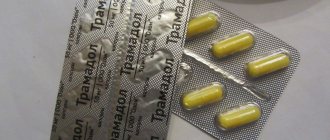Contraindications
- arterial hypotension;
- hypercatecholaminemia;
- history of jaundice, fever or fever of unexplained origin after administration of halothane;
- pheochromocytoma;
- known or suspected genetic predisposition to malignant hyperthermia;
- myasthenia gravis;
- a period of less than 3 months after the administration of halothane for general anesthesia;
- age up to 18 years when performing dental procedures outside a hospital setting;
- childbirth and early postpartum period;
- I trimester of pregnancy;
- hypersensitivity to the components of the drug.
Ftorotan is prescribed with caution during simultaneous therapy with cardiac glycosides.
Stop breastfeeding for 24 hours after using the drug.
Directions for use and dosage
The liquid is used for any type of inhalation anesthesia. Using a calibration sprayer, which is located outside the closed circulation system, the required dose is selected.
In adults, induction of anesthesia at a flow rate of 8000 ml per minute begins with the supply of Ftorotan in a concentration of 0.5 volume % (with oxygen), then the concentration of drug vapor in the mixture is gradually increased to 0.5–3 volume %. As a rule, for adults, 0.5–1.5% by volume is sufficient as a maintenance concentration.
Children, including newborns, require greater concentrations during induction than adults.
Elderly patients are prescribed a lower dose of the drug. The current dose is determined based on the physical condition of the patient.
In most cases, after 4–6 minutes after administration, the surgical stage of anesthesia is achieved.
The minimum alveolar concentration of halothane for adults when mixed with nitrous oxide is 0.3% by volume, with oxygen - 0.77% by volume; for children aged <6 months when mixed with oxygen – 1.08% by volume, children aged <10 years – 0.92% by volume; for patients aged > 70 years – 0.64% by volume.
To eliminate possible hypercapnia and achieve faster elimination of Ftorotan, the oxygen flow is increased after the end of the operation.
Before anesthesia, patients are administered metacin or atropine to avoid the development of side effects associated with excitation of the vagus nerve (arrhythmia, bradycardia). It is recommended to use promedol instead of morphine for premedication, since the former has a less stimulating effect on the centers of the vagus nerve. To enhance muscle relaxation (if necessary), relaxants of a depolarizing type of action (ditilin) are prescribed; when prescribing drugs of a non-depolarizing (competitive) type, their dose is reduced compared to the usual one. When using muscle relaxants (in cases of controlled breathing), the concentration of fluorotane should not be greater than 1–1.5% by volume.
Pharmacological action of Ftorotan
The active component of Ftorotan is a powerful narcotic drug. This allows you to use it independently for anesthesia during surgical operations of varying complexity for people of all ages. Ftorotan is characterized by a rapid introduction to anesthesia with a minimal stage of excitation. Most often, this type of anesthesia is used during operations in which it is necessary to avoid overexcitation, for example, in neurosurgery and ophthalmic surgery.
It can also be combined with other anesthetics (usually nitrous oxide). Fluorotane is an integral part of the azeotron mixture, where it is included in equal parts along with ether. This anesthesia mixture has a stronger and faster effect than ether, but less pronounced than Ftorotan.
Ftorotan has a rapid effect - the surgical stage of anesthesia usually occurs in 3-5 minutes. After stopping the supply of anesthesia, awakening begins. After short-term anesthesia, the disappearance of anesthesia depression is observed after 5-10 minutes, and after prolonged general anesthesia - after 30-40 minutes.
For premedication, it is more preferable to use promedol rather than morphine, which has less stimulation on the centers of the vagus nerve.
Ftorotan vapors do not cause irritation of the mucous membranes, however, a decrease in blood pressure is observed, which is caused by its inhibitory effect on the sympathetic ganglia and dilation of peripheral vessels.
In order not to cause ventricular fibrillation, simultaneous use of Ftorotan with adrenaline and norepinephrine is not recommended, which is associated with increased sensitivity of the myocardium to catecholamines. Ftorotan has no effect on kidney function.
Side effects
- central nervous system: tremor, headache (after the patient awakens), increased intracranial pressure;
- cardiovascular system: heart rhythm disturbances, bradycardia, arterial hypotension;
- digestive system: impaired liver function, including hepatitis, jaundice, liver necrosis (especially with repeated administrations); postoperative vomiting, nausea (after the patient awakens);
- other: depressed breathing, eosinophilia, malignant hyperthermia (including impaired gas exchange, severe tachycardia, a sharp increase in the child’s body temperature to 40–42°C, a drop in blood pressure, cerebral edema, death).
special instructions
The drug is hepatotoxic because, when it enters the liver, it is converted into free radicals, initiators of lipid peroxidation, and also forms metabolites (fluoroethanol) that covalently bind to biomacromolecules. In adult patients, the chance of developing hepatitis is 1 in 10,000 times anesthesia. Liver damage in children is observed much less frequently.
Ftorotan causes muscle relaxation, and therefore it is prescribed with caution for myasthenia gravis and/or concomitant therapy with aminoglycoside antibacterial drugs. During anesthesia, there may be an increase in intracranial pressure and/or an increase in blood flow in the vessels of the brain. These effects are in most cases more pronounced against the background of intracranial neoplasms. To counter them, moderate hyperventilation is used in neurosurgery.
It should be taken into account that during treatment children may develop unsystematic tachycardia.
Monitoring the patient’s condition during anesthesia is carried out by monitoring the following indicators:
- pulse;
- blood pressure (measured manually or automatically, directly and indirectly);
- continuous recording of the electrocardiogram;
- oxygen content in the blood (the color of the skin and mucous membranes is taken into account using a blood test or pulse oximeter);
- body core and surface temperature;
- diuresis rate;
- blood gas test;
- electrolyte composition;
- acid-base state.
The liquid should not be stored in evaporators; Before new use, the evaporator is cleaned of drug residues and its decomposition products. Thymol used for stabilization does not evaporate; it remains in the evaporator, giving the solution a yellow tint; it is highly soluble and can be removed with ether.
Levodopa therapy is discontinued 6–8 hours before general anesthesia.
In chronic alcoholism, large doses are used for anesthesia.
For 24 hours after anesthesia, patients should refrain from engaging in potentially hazardous activities that require increased attention and speed of psychomotor reactions.
FTOROTANE
Description of the active substance (INN):
Halothane
Dosage form:
liquid for inhalation, solution for inhalation
Pharmachologic effect:
A means for inhalational general anesthesia that causes rapid induction of anesthesia without or with minimal manifestation of the excitation stage. It has an analgesic and muscle relaxant effect (does not create sufficient muscle relaxation, and therefore additional use of muscle relaxants is required). Blocks the ganglia of the sympathetic nervous system, dilates the arteries of the skin and muscles, and reduces blood pressure. Increases n.vagus tone, causing bradycardia. Due to the direct negative inotropic effect, it reduces myocardial contractility and stroke volume. By increasing the sensitivity of cardiomyocytes to catecholamines, it increases the likelihood of developing arrhythmias. Does not irritate the respiratory tract, does not cause increased secretion of saliva and bronchial glands, has a moderate bronchodilator effect, inhibits cough and gag reflexes; in proportion to the depth of general anesthesia, it weakens the contractility of the uterus; does not cause acidosis. At a concentration of 0.5 to 3-4 vol.%, the surgical stage of anesthesia is achieved in 4-6 minutes; after the end of general anesthesia, awakening occurs in 5-15 minutes.
Indications:
Inhalation general anesthesia for major and minor surgical interventions; as an anesthetic for COPD, bronchial asthma and diabetes.
Contraindications:
Hypersensitivity, period of labor, pregnancy (first trimester), jaundice, malignant hyperthermia (history of halothane), liver disease, intracranial hypertension, need for local use of epinephrine in the surgical field (risk of arrhythmias); pheochromocytoma, thyrotoxicosis, hypercatecholaminemia, liver failure, arterial hypotension, arrhythmias, myasthenia gravis, period after general anesthesia with halothane (3 months). With caution. Taking cardiac glycosides.
Side effects:
Decreased blood pressure, bradycardia, increased sensitivity of the heart to catecholamines, arrhythmias, respiratory depression, liver dysfunction (jaundice, hepatitis, hepatonecrosis), intracranial hypertension, malignant hyperthermia, post-anesthesia delirium. After waking up - headache, nausea, tremor. Overdose. Symptoms: severe bradycardia, arrhythmias, decreased blood pressure, hyperthermic crisis, respiratory depression. Treatment: mechanical ventilation with pure oxygen.
Directions for use and dosage:
Suitable for any type of inhalation anesthesia. The correct dosage is achieved using a calibrated evaporator located outside the closed circulation system (to avoid overdose). To induce anesthesia, the concentration of halothane vapor in oxygen or a mixture of oxygen and dinitrogen oxide is gradually increased to 3-4 vol.%. When introducing anesthesia using an intravenous anesthetic followed by the administration of a muscle relaxant, halothane with oxygen is used only to maintain anesthesia, the usual maintenance concentration is 0.5-2 vol.%. A blood concentration of 7-12 mg% corresponds to the surgical stage of general anesthesia, and depression of the respiratory center is observed at a concentration of 30-38 mg%. The minimum alveolar concentration (MAC) in adults is 0.77 vol.%, with the addition of 70 vol.% dinitrogen oxide it is reduced to 0.3 vol.%, which corresponds to a content of 16 and 6 mg% in the blood. Premedication with morphine has little effect on MAC. MAC for children under 6 months - 1.08 vol.%; up to 10 years - 0.92 vol.%; for persons over 70 years old - 0.64 vol.%.
Special instructions:
Cannot be stored in evaporators; Before new use, the evaporator must be cleaned of residual halothane and its decomposition products. Thymol (used for stabilization) does not evaporate; it remains in the evaporator, coloring the solution yellowish; it is highly soluble and can be eliminated with ether. It is necessary to discontinue levodopa 6-8 hours before the start of general anesthesia. Patients with chronic alcoholism require large doses for anesthesia.
Interaction:
Adrenergic stimulants increase the risk of developing arrhythmias. Strengthens the effect of non-depolarizing muscle relaxants, antihypertensive drugs, bradycardia under the influence of digitalis drugs and cholinesterase inhibitors (neostigmine), weakens the effect of uterotonic drugs. Morphine and phenothiazines enhance the depressant effect on the central nervous system. Increases the risk of liver damage with phenytoin. Aminoglycosides, lincomycin and polymyxins deepen the neuromuscular blockade (can cause apnea). Ketamine increases T1/2; methyldopa, dinitrogen oxide, morphine and phenothiazines - the strength of general anesthesia. The likelihood of developing malignant hyperthermia is increased by suxamethonium, and arrhythmias by xanthine.
Drug interactions
The effect of halothane on drugs/substances during combination therapy:
- uterotonics: weakens their effect;
- antihypertensive drugs, muscle relaxants of non-depolarizing action: enhances their effect;
- tubocurarine chloride: enhances and prolongs its action and toxicity;
- ganglion blockers: potentiates their action, and therefore they are prescribed in smaller doses;
- drugs that cause uterine contractions (ergot alkaloids, oxytocin): reduces the sensitivity of the uterus to them.
Effect of drugs/substances on halothane when administered in combination:
- morphine, phenothiazine derivatives: enhance its depressant effect on the central nervous system;
- ketamine: prolongs its half-life;
- phenothiaziazines, morphine, nitrous oxide, methyldopa: increase the strength of general anesthesia;
- monoamine oxidase inhibitors: aggravate its toxic effect;
- nitrous oxide, opioid analgesics: enhance its analgesic effect.
When halothane is used simultaneously with certain drugs/substances, the following effects may develop:
- sympathomimetics: increased risk of arrhythmias;
- phenytoin: increased risk of liver damage;
- polymyxin, lincomycin, aminoglycosides: deepening of neuromuscular blockade (possible development of apnea);
- suxamethonium: increased likelihood of developing malignant hyperthermia;
- xanthine: increased likelihood of developing arrhythmia;
- oxytocin: possible development of arterial hypotension, sinus bradycardia, pathological atrioventricular rhythm in the mother during childbirth;
- monoamine oxidase inhibitors: risk of increased blood pressure;
- timolol in the form of eye drops: development of hypotension and bradycardia when instilled before surgery;
- theophylline, sympathomimetics: increased likelihood of developing heart rhythm disturbances;
- antidepolarizing muscle relaxants, aminoglycosides: increased neuromuscular blockade;
- Digitalis preparations, cholinesterase inhibitors: increased bradycardia.
The drug can reduce the tone of the uterine muscles and increase bleeding, which is important to consider before performing gynecological operations.
Since Ftorotan relaxes the uterus, its use in obstetric practice is justified only in cases where relaxation of the uterus is necessary.
FLUOROTANE. Phthorothanum.Properties. A transparent, colorless, heavy, highly volatile, but non-flammable liquid with a mild odor reminiscent of chloroform or trichlorethylene. Specific gravity 1.869-1.874. Boiling point 49-51 °C. Slightly soluble in water (0.345%), mixes well with ether, chloroform, trichlorethylene, volatile and non-volatile oils, and anhydrous alcohol. Fluorotane vapor mixed with oxygen and nitrous oxide in the ratios used for anesthesia is not explosive and does not ignite.
Release form. Available in dark glass bottles of 50 and 250 ml.
Store according to list B, in standard packaging, in a dry, cool place, protected from light. Every six months of storage, the drug is checked for suitability.
Action and application.
In terms of its effect on the central nervous system, it occupies an intermediate position between chloroform and ether and is one of the most active agents for inhalation anesthesia.
In the mechanism of the central action of ftorotan, its blocking effect on the cerebral cortex and hippocampus is essential. It diffuses well through the lungs, which allows you to quickly create a narcotic concentration in the blood. Unlike ether, fluorotane quickly causes anesthesia, which occurs without a phase of motor excitation; recovery from anesthesia is also quick and without side effects. It is excreted unchanged from the body in exhaled air.
Inhalation of fluorotane in high concentrations can cause respiratory arrest followed by cardiac arrest.
During surgical anesthesia, a decrease in blood pressure and a slowdown in heart rate are observed. All these effects are due to the inhibitory effect of fluorotane on the sympathetic ganglia, dilation of peripheral vessels and increased tone of the vagus nerve. Ftorotan sensitizes the heart muscle to adrenaline and norepinephrine, which during anesthesia can cause ventricular fibrillation, which can be eliminated by administering mezatone.
Due to the fact that fluorothane is a halogenated hydrocarbon, there is reason to believe that it has a toxic effect on the liver; An increase in the concentration of carbon dioxide in the blood obviously increases the toxic effect of fluorotane on the liver, therefore, during anesthesia, it is necessary to ensure blood saturation with oxygen and prevent the accumulation of carbon dioxide.
Ftorotan is used as an inhaled narcotic during all kinds of surgical operations. To obtain anesthesia it is used in a concentration of 3-5 vol. % in the inhaled mixture. With the onset of anesthesia, the concentration of the drug in the inhaled air is reduced by 2 times.
Fluorothane anesthesia is carried out through a regular anesthesia mask or using special devices with an evaporator outside the air circulation system. In order to prevent bradycardia and arrhythmia, it is advisable to administer atropine to the animal before inhalation of fluorotane; To enhance relaxation of striated muscles, relaxants of a depolarizing type of action (ditiline) are prescribed. It can be used in a mixture with oxygen or nitrous oxide; and also mixed with ether.
Fluorotane anesthesia is well tolerated by pigs, sheep, and goats; for this purpose, the drug is used by inhalation in a total dose of no more than 2-2.5 ml per 1 kg of weight, which provides anesthesia duration of up to 45-55 minutes. For horses and cattle, fluorotane is used to maintain thiopental anesthesia.







